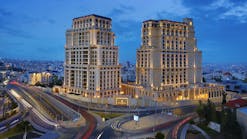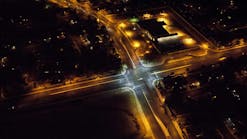A prominent feature of the city centre, the West Gate building was designed by renowned British architect Sir Giles Gilbert Scott, who also designed Bankside power stations (now the Tate Modern gallery) and the classic red British telephone box.
Because of the building's "listed" status, no signage could be attached to the exterior. Keen to embrace new technology, Royal & SunAlliance decided that lighting was an inventive solution that would also create local interest and give the building a new nocturnal presence compatible with the City Council's desire to improve the visual impact of lighting in the city centre.
The 12 fully-weatherised PixelPAR 90s supplied by James Thomas Engineering are mounted on a ledge around the bottom of the building's curved front fascia, beaming upwards and producing a fabulously smooth and even coverage. The fascia width is approximately 100 ft and the curve is 120 degrees.The fixtures are programmed to step through a colour-changing sequence of green, yellow and blue – Royal & SunAlliance's corporate colours. For special occasions the building is changed into specific colour schemes e.g. red for Remembrance Day or rainbow colours for Christmas. The lighting can also be used to highlight special promotions.
Initially, metal halide lamps were specified, but in the more than 2 years that elapsed before planning approval was received, PixelPARs came onto the market. They were "a far superior product" states Darren Wring of Bristol-based Fineline, who won the project's specialist lighting installation contract.
Fineline conducted a demo using PixelPAR 90s rather than metal halide lamps. The LED sources not only covered the area better, but also had the massive advantages of being physically more discreet, needing no bulb changes and very little maintenance.
Their low power consumption meant that R&SA would not only save money on long-term everyday running costs and be more environmentally friendly, but that the electrical plant installation – power and cabling – could be scaled right down. The power supply was accordingly reduced from a 63 amp 3-phase supply to two single 16 amp feeds.







